The History Teacher

By Billy Collins
In ‘The History Teacher,’ the titular educator neglects to teach his students about the cold, hard realities of the past in order to protect their innocence from reality.
Billy Collins
Nationality: American
He has often been referred to as the “most popular poet in America.”

Poem Analyzed by Emma Baldwin
B.A. English (Minor: Creative Writing), B.F.A. Fine Art, B.A. Art Histories
‘The History Teacher’ was first published in Collins’s 1991 collection, Questions About Angels. It was with this collection that his star began to rise. It is generally cited as his best-known volume. Like the majority of Collins’s poems, he uses humor and a satirical outlook on the world in order to make a larger point about a specific topic. The teacher in this poem ignores the negative impact of the revised history lessons that he’s giving. The lessons of history were not passed down to the next generation.
Explore The History Teacher
- 1 Summary of The History Teacher
- 2 Structure of The History Teacher
- 3 Literary Devices in The History Teacher
- 4 Analysis of The History Teacher

Summary of The History Teacher
In the first lines of this poem, the reader is introduced to a teacher who, out of fear of upsetting his students, decides to simplify history. He takes scary events and makes them lighter and easier to understand. The Stone Age becomes the Gravel Age and the Spanish Inquisition a period in which people couldn’t stop asking questions.
But, this choice on the teacher’s part has an impact on the students that he didn’t expect. Since they aren’t taught about history’s mistakes they repeat those same mistakes in the form of cruelty and bullying outside the school. Yet, the teacher continues in the same mindset, contemplating changing the Boer War to a war of boring stories.
Structure of The History Teacher
‘ The History Teacher’ by Billy Collins is a six stanza poem that is separated into sets of either two, three, four, or five lines. These stanzas vary in length, as do the length of the individual lines. There are several, such as line three of stanza four and line three of stanza six that are markedly shorter than those around them. This is a feature of Collins choosing the structure of these stanzas as sentences.
Collins does not make use of a specific rhyme scheme or meter in ‘The History Teacher’ (a technique known as free verse ). But, that does not mean that the poem is entirely without rhyme . There are several examples of half-rhyme within the text. Also known as slant or partial rhyme, half-rhyme is seen through the repetition of assonance or consonance . This means that either a vowel or consonant sound is reused within one line or multiple lines of verse . For example, “leave” and “weak” in stanza five and “Chilly” and “million” in line three of stanza one. “Boer War” in the sixth stanza is another good example.
Literary Devices in The History Teacher
Collins makes use of several literary devices in ‘The History Teacher’. These include but are not limited to allusion , enjambment , and alliteration . The latter, alliteration, occurs when words are used in succession, or at least appear close together, and begin with the same sound. For example, “Madrid” and “Matador” in stanza three and “flower” and “fences” in stanza six.
Another important technique commonly used in poetry is enjambment. It occurs when a line is cut off before its natural stopping point. Enjambment forces a reader down to the next line, and the next, quickly. One has to move forward in order to comfortably resolve a phrase or sentence. For example, the transitions between lines one, two, and three of stanza four.
Analysis of The History Teacher
Stanza one .
Trying to protect his students’ innocence (…) when everyone had to wear sweaters.
In the first stanza of this ‘The History Teacher ,’ the speaker begins by explaining the thought process of a history teacher. This history teacher, worried that the true history of the world is going to upset his students decides to make history more palatable. Rather than explain what the Ice Age really was, he decides to tell his students that it was just a period in which everyone wore sweaters.
A reader should take note of the use of enjambment in the stanza. All three first lines are enjambed, making up one long sentence. This makes a great deal of sense for this particular palm as the narrator is telling a story of the speaker and his teaching methods.
Stanza Two
And the Stone Age became the Gravel Age, (…)
The second stanza is similar to the first. Rather than explain the Stone Age, its complexities, and its hardships, the teacher refers to it as the “Gravel Age”. This is a very funny twist in which people supposedly had “long driveways”. At this point, the true implications of transforming history are not clear.
Stanza Three
The Spanish Inquisition was nothing more (…) “What do you call the matador’s hat?”
In the third and fourth stanza of ‘The History Teacher,’ the speaker makes allusions to several other historical events. He mentions the Spanish Inquisition, a period of religious persecution and torture, and refers to it as an age in which everyone asked questions. Again, humorous at first but more problematic when the implications become clear.
Stanza Four
The War of the Roses took place in a garden, (…)
The same can be said of the fourth stanza in which he talks about the war of the roses and Enola Gay the B-29 bomber plane that dropped an atomic bomb, Little Boy, on Hiroshima. Rather than one atomic bomb, the teacher tells them that the plane dropped one atom.
The line breaks in the fourth stands are quite effective. Specifically between the second and third lines. The transformation of history in this example is emphasizing through the transition between “Adam“ and “on Japan“.
Stanza Five
The children would leave his classroom (…) mussing up their hair and breaking their glasses,
The fifth stanza of ‘The History Teacher’ is the only one in which the reader is exposed to the consequences of altering history. The old saying that “if one does not learn from history is doomed to repeat itself” is playing out in the schoolyard. The students, unaware of these tragic mistakes and circumstances of their own pasts, “torment the week” and bully those they can.
Stanza Six
while he gathered up his notes and walked home past flower beds and white picket fences, (…) designed to make the enemy nod off.
In the final stanza of ‘The History Teacher,’ the teacher, either unaware or unwilling to address, the effects of his teaching method is on his way home. He makes one final consideration in this poem about the Boer War. This is an allusion to a war fought between the British Empire and two independent Boer states. During this terrible period, 26,000 civilians died of disease in concentration camps set up in South Africa. The British lost a total of 28,000 men and the Boer, 4,000.
Rather than have to confront their past the teacher contemplates whether it would be possible to convince his students that the war was in fact about soldiers exchanging boring stories. The poem concludes without a clear resolution very much suggesting that the practice of altering the past is going to continue, as are the implications of not learning from it.
Home » Billy Collins » The History Teacher

About Emma Baldwin
Join the poetry chatter and comment.
Exclusive to Poetry + Members
Join Conversations
Share your thoughts and be part of engaging discussions.
Expert Replies
Get personalized insights from our Qualified Poetry Experts.
Connect with Poetry Lovers
Build connections with like-minded individuals.
Access the Complete PDF Guide of this Poem

Poetry+ PDF Guides are designed to be the ultimate PDF Guides for poetry. The PDF Guide consists of a front cover, table of contents, with the full analysis, including the Poetry+ Review Corner and numerically referenced literary terms, plus much more.
Get the PDF Guide
Experts in Poetry
Our work is created by a team of talented poetry experts, to provide an in-depth look into poetry, like no other.
Cite This Page
Baldwin, Emma. "The History Teacher by Billy Collins". Poem Analysis , https://poemanalysis.com/billy-collins/the-history-teacher/ . Accessed 13 June 2024.

Help Center
Request an Analysis
(not a member? Join now)
Poem PDF Guides
PDF Learning Library
Poetry + Newsletter
Poetry Archives
Poetry Explained
Poet Biographies
Useful Links
Poem Explorer
Poem Generator
Poem Solutions Limited, International House, 36-38 Cornhill, London, EC3V 3NG, United Kingdom
Discover and learn about the greatest poetry, straight to your inbox
Unlock the Secrets to Poetry
Download Poetry PDFs Guides
Complete Poetry PDF Guide
Perfect Offline Resource
Covers Everything Need to Know
One-pager 'snapshot' PDF
Offline Resource
Gateway to deeper understanding
Get this Poem Analysis as an Offline Resource
Poetry+ PDF Guides are designed to be the ultimate PDF Guides for poetry. The PDF Guide contains everything to understand poetry.

The History Teacher Summary & Analysis by Billy Collins
- Line-by-Line Explanation & Analysis
- Poetic Devices
- Vocabulary & References
- Form, Meter, & Rhyme Scheme
- Line-by-Line Explanations
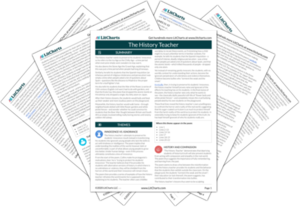
"The History Teacher" first appeared in Billy Collins's 1991 poetry collection Questions About Angels . The poem depicts a history teacher who strives to preserve his students' innocence by telling them sugarcoated, fictitious versions of historical events with all suffering or cruelty removed. Despite his efforts to hide the truth about history—or perhaps because of them—his students become cruel and violent, bullying and beating up their peers on the playground. The history teacher remains unaware of the negative effects of his lessons, seemingly happy to live within the idyllic world that he has created for his ignorant pupils. Collins mixes his traditional wry sense of humor with a striking, serious message about the dangers of keeping learners from the truth.
- Read the full text of “The History Teacher”
| LitCharts |

The Full Text of “The History Teacher”
“the history teacher” summary, “the history teacher” themes.

Innocence vs. Ignorance
- Lines 14-16
- Lines 18-19
- Lines 20-22

History and Compassion
Lines 14-17.

The Danger of Misinformation
Line-by-line explanation & analysis of “the history teacher”.
Trying to protect ... ... to wear sweaters.

And the Stone ... ... of the time.
The Spanish Inquisition ... ... the matador's hat?"
Lines 11-13
The War of ... ... on Japan.
The children would ... ... breaking their glasses,
Lines 18-22
while he gathered ... ... enemy nod off.
“The History Teacher” Symbols
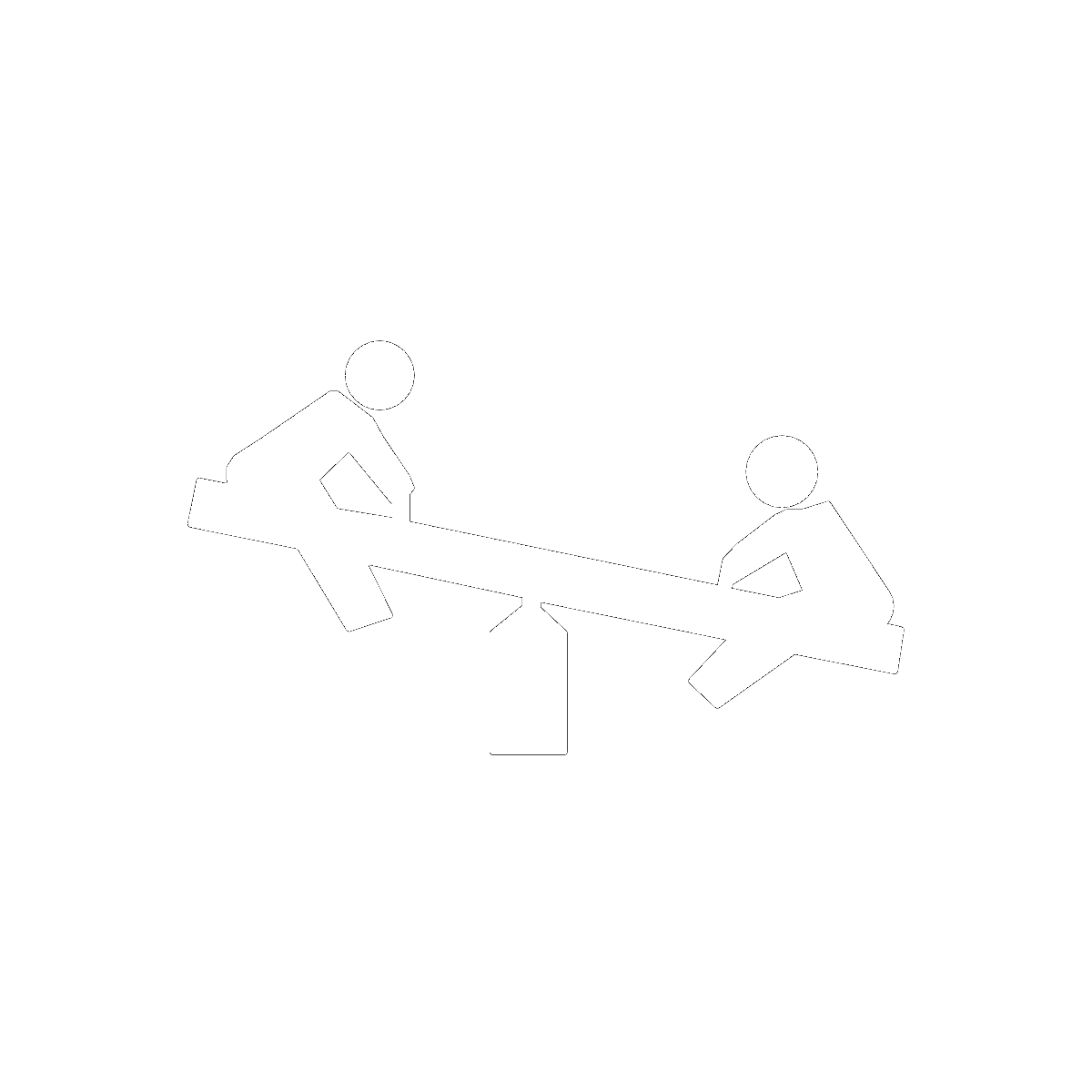
Playground Violence
- Lines 14-17: “The children would leave his classroom / for the playground to torment the weak / and the smart, / mussing up their hair and breaking their glasses,”

Flower Beds and White Picket Fences
- Line 19: “past flower beds and white picket fences,”
“The History Teacher” Poetic Devices & Figurative Language
Alliteration.
- Line 9: “Madrid”
- Line 10: “matador's”
- Line 15: “to torment”
- Line 18: “while ,” “walked”
- Line 19: “flower ,” “white,” “fences”
- Line 20: “wondering,” “ would”
- Line 21: “War ”
- Line 2: “the Ice Age”
- Line 5: “the Stone Age”
- Line 7: “The Spanish Inquisition”
- Line 11: “The War of the Roses”
- Lines 12-13: “the Enola Gay dropped one tiny atom / on Japan.”
- Line 21: “the Boer War ”
- Line 1: “protect,” “students,” “innocence”
- Line 3: “Chilly,” “million”
- Line 4: “everyone,” “sweaters”
- Line 6: “driveways,” “time”
- Line 10: “matador's,” “hat”
- Line 12: “atom”
- Line 13: “Japan”
- Line 18: “notes,” “home”
- Line 19: “beds,” “fences”
- Line 21: “Boer War,” “stories”
- Line 22: “nod off”
- Line 1: “Trying,” “to,” “protect,” “students,” “innocence”
- Line 2: “told,” “really”
- Line 10: “What,” “matador's,” “hat”
- Line 12: “dropped,” “tiny,” “atom”
- Line 15: “to,” “torment”
- Line 16: “smart”
- Line 17: “mussing,” “glasses”
- Line 18: “gathered,” “walked”
- Line 19: “past,” “flower,” “beds,” “white,” “picket,” “fences”
- Line 20: “wondering,” “would,” “believe”
- Line 21: “Boer,” “War,” “rambling”
- Line 22: “designed,” “make,” “enemy,” “nod”
End-Stopped Line
- Line 4: “sweaters.”
- Line 5: “Age,”
- Line 6: “time.”
- Line 9: “Madrid?"”
- Line 10: “hat?"”
- Line 11: “garden,”
- Line 13: “Japan.”
- Line 16: “smart,”
- Line 17: “glasses,”
- Line 19: “fences,”
- Line 22: “off.”
- Lines 1-2: “innocence / he”
- Lines 2-3: “ just / the ”
- Lines 3-4: “years / when”
- Lines 7-8: “more / than”
- Lines 8-9: “as / "How”
- Lines 12-13: “atom / on”
- Lines 14-15: “classroom / for”
- Lines 15-16: “weak / and”
- Lines 18-19: “home / past”
- Lines 20-21: “soldiers / in”
- Lines 21-22: “stories / designed”
- Line 1: “Trying to protect his students' innocence”
- Lines 14-22: “The children would leave his classroom / for the playground to torment the weak / and the smart, / mussing up their hair and breaking their glasses, / while he gathered up his notes and walked home / past flower beds and white picket fences, / wondering if they would believe that soldiers / in the Boer War told long, rambling stories / designed to make the enemy nod off.”
Juxtaposition
- Lines 14-22
- Lines 7-8: “The Spanish Inquisition was nothing more / than an outbreak of questions”
- Lines 20-22: “soldiers / in the Boer War told long, rambling stories / designed to make the enemy nod off.”
“The History Teacher” Vocabulary
Select any word below to get its definition in the context of the poem. The words are listed in the order in which they appear in the poem.
- Spanish Inquisition
- War of the Roses
- (Location in poem: Line 2: “Ice Age”)
Form, Meter, & Rhyme Scheme of “The History Teacher”
Rhyme scheme, “the history teacher” speaker, “the history teacher” setting, literary and historical context of “the history teacher”, more “the history teacher” resources, external resources.
The Poem Out Loud — Watch a video of "The History Teacher" read aloud and accompanied by a series of illustrations.
The Boer War — Learn more about the war referenced in the end of the poem (which had nothing to do with "boring" soldiers!).
Collins's Voice — This video provides an opportunity to hear Billy Collins's dryly witty delivery of his own poetry followed by a lengthy interview.
The War of the Roses — The real story of the War of the Roses, which did not take place in a garden (but did inspire the Game of Thrones series!).
Biography of Billy Collins — This biographical portrait of Billy Collins offers a thorough chronology of his work and a variety of responses from critics.
The Spanish Inquisition — Read what the Inquisition actually entailed (hint: it was not about matador hats).
The Enola Gay — Read about the plane that dropped the atomic bomb on Japan.
New York Times Review — This New York Times review of a 2001 Billy Collins collection that reprinted "The History Teacher" quotes and analyzes the poem's impact at length.
LitCharts on Other Poems by Billy Collins
Afternoon with Irish Cows
Introduction to Poetry
On Turning Ten
The Art of Drowning
Ask LitCharts AI: The answer to your questions


Lit. Summaries
- Biographies
Unpacking ‘The History Teacher’: A Literary Analysis of Billy Collins’ Poem
- Billy Collins
“The History Teacher” is a well-known poem by Billy Collins that has gained popularity for its satirical and humorous take on the education system. In this literary analysis, we will delve deeper into the themes and literary devices used by Collins in this poem, and explore the underlying message that he conveys through his words. Join us as we unpack “The History Teacher” and discover the hidden layers of meaning within this seemingly simple poem.
Historical Context
The historical context of Billy Collins’ poem “The History Teacher” is crucial to understanding its underlying message. The poem was published in 1996, a time when the United States was grappling with its own history and the way it was taught in schools. The country was still reeling from the Cold War and the Gulf War, and the education system was under scrutiny for its lack of diversity and inclusion.
Collins’ poem speaks to these issues by highlighting the dangers of a narrow and biased education. The history teacher in the poem is portrayed as someone who manipulates the facts to fit his own agenda, teaching his students a sanitized version of history that ignores the darker aspects of the past. This is a critique of the way history was often taught in the 1990s, with a focus on American exceptionalism and a reluctance to confront the country’s history of racism, imperialism, and violence.
At the same time, the poem also reflects a broader cultural shift towards postmodernism and skepticism towards grand narratives. The history teacher’s insistence on a single, authoritative version of history is contrasted with the students’ playful and imaginative approach to the subject. This reflects a growing awareness that history is not a fixed and objective truth, but rather a contested and subjective interpretation of the past.
Overall, the historical context of “The History Teacher” is one of a society grappling with its own history and the way it is taught. Collins’ poem offers a powerful critique of the dangers of a narrow and biased education, while also reflecting broader cultural shifts towards postmodernism and skepticism towards grand narratives.
Structure and Form
The structure and form of Billy Collins’ poem “The History Teacher” play a significant role in conveying the poem’s message. The poem is written in free verse, with no set rhyme scheme or meter. This lack of structure reflects the chaos and confusion that the history teacher experiences as he tries to rewrite history to make it more palatable for his students.
The poem is divided into four stanzas, each with varying line lengths. The first stanza sets the scene and introduces the history teacher, while the second and third stanzas describe the teacher’s attempts to rewrite history. The final stanza brings the poem to a close, with the teacher’s realization that he cannot change the past.
Collins also uses repetition throughout the poem, with the phrase “forget what you already know” appearing multiple times. This repetition emphasizes the teacher’s desperation to make his students forget the truth and accept his version of history.
Overall, the structure and form of “The History Teacher” contribute to the poem’s themes of truth, memory, and the power of storytelling.
Themes and Motifs
One of the prominent themes in Billy Collins’ poem “The History Teacher” is the idea of manipulation and control. The teacher in the poem is portrayed as someone who has the power to shape the minds of his students and control the narrative of history. However, this power is used in a negative way as the teacher alters the facts to fit his own agenda and beliefs. This theme is further emphasized through the use of language and imagery, such as the teacher’s “blackboard jungle” and the “chalk dust” that clouds the truth. Another important motif in the poem is the idea of innocence and corruption. The students are portrayed as innocent and naive, while the teacher is corrupt and manipulative. This motif is highlighted through the use of contrasting imagery, such as the “innocent blue eyes” of the students and the “savage parade” that the teacher leads them on. Overall, these themes and motifs work together to create a powerful commentary on the dangers of manipulation and the importance of truth in education.
Imagery and Symbolism
In Billy Collins’ poem “The History Teacher,” imagery and symbolism play a significant role in conveying the theme of the dangers of selective memory and the manipulation of history. The poem’s opening lines, “Trying to protect his students’ innocence / he told them the Ice Age was really just / the Chilly Age, a period of a million years / when everyone had to wear sweaters,” immediately establish the teacher’s attempt to shield his students from the harsh realities of history. The use of the word “innocence” suggests that the teacher believes his students are too young or naive to handle the truth, and his revisionist history serves as a form of censorship.
Throughout the poem, Collins employs vivid imagery to illustrate the consequences of the teacher’s actions. For example, when the teacher tells his students that “Indians sent smoke signals to Europe,” the image of smoke signals crossing the Atlantic Ocean is absurd and highlights the teacher’s absurd attempts to rewrite history. Similarly, the image of the teacher “rubbing a chalky talcum powder / into his hands, as if he were an athlete / preparing to enter a game” suggests that he sees himself as a performer rather than an educator, further emphasizing his manipulation of the truth.
Symbolism is also used to convey the poem’s theme. The teacher’s “blackboard” is a symbol of the power he holds over his students’ understanding of history. By erasing and rewriting history on the board, he is able to shape his students’ perceptions of the past. The “textbook” is another symbol of the teacher’s control, as it is the source of the information he chooses to present to his students.
Overall, the use of imagery and symbolism in “The History Teacher” serves to highlight the dangers of manipulating history and the importance of presenting the truth, even if it is uncomfortable or difficult to confront.
Tone and Mood
The tone and mood of Billy Collins’ poem “The History Teacher” are crucial to understanding the poem’s message. The tone is ironic and satirical, as the speaker describes a history teacher who alters the facts to make them more palatable for his students. The mood is unsettling, as the reader realizes the implications of this behavior. The poem’s tone and mood work together to create a sense of unease and to highlight the importance of truth in education.
Language and Diction
In “The History Teacher,” Billy Collins uses language and diction to convey the absurdity of the teacher’s actions. The poem is written in a conversational tone, with simple language and straightforward syntax. This creates a sense of familiarity and comfort, which is quickly disrupted by the teacher’s outrageous lies. The use of hyperbole and exaggeration in phrases such as “the children would leave his classroom / for the playground to torment the weak / and the smart” emphasizes the absurdity of the teacher’s actions and highlights the danger of rewriting history. Additionally, the repetition of the phrase “forget what you already know” reinforces the idea that the teacher is attempting to manipulate his students and erase their knowledge of the past. Overall, Collins’ use of language and diction effectively conveys the unsettling nature of the teacher’s actions and the importance of preserving the truth in history.
Narrative Perspective
The narrative perspective of Billy Collins’ poem “The History Teacher” is crucial to understanding the poem’s message. The poem is written in the first-person point of view, with the speaker being the history teacher himself. This perspective allows the reader to see the world through the teacher’s eyes and understand his motivations and thought processes. The teacher’s perspective is also important because it highlights the power dynamic between teacher and student. The teacher is in a position of authority and has the ability to shape his students’ understanding of history. However, the poem suggests that the teacher is using this power to manipulate his students and rewrite history to fit his own agenda. By using the first-person point of view, Collins is able to create a sense of intimacy between the reader and the teacher, making the poem’s message all the more impactful.
Character Analysis
In “The History Teacher,” Billy Collins presents a character who is both relatable and unsettling. The titular teacher is portrayed as someone who wants to protect his students from the harsh realities of history, but in doing so, he distorts the truth and perpetuates a cycle of ignorance. Through his use of vivid imagery and irony, Collins reveals the flaws in the teacher’s character and the consequences of his actions. As readers, we are left to question the role of education in shaping our understanding of the world and the responsibility of those who teach it.
Interpretation and Analysis
In “The History Teacher,” Billy Collins presents a satirical take on the education system and the way history is taught in schools. The poem follows a history teacher who alters historical events to make them more palatable for his students, ultimately leading to a distorted understanding of the past.
Through his use of irony and humor, Collins highlights the dangers of sugarcoating history and the importance of acknowledging the complexities and nuances of the past. The poem also raises questions about the role of education in shaping our understanding of the world and the responsibility of teachers to present accurate information.
Overall, “The History Teacher” serves as a poignant commentary on the state of education and the need for critical thinking and a nuanced understanding of history.
Comparative Analysis
In comparing “The History Teacher” to other works of literature, it becomes clear that Collins is using satire to comment on the state of education in America. The poem’s tone and structure are reminiscent of Jonathan Swift’s “A Modest Proposal,” which similarly uses irony to criticize societal issues. Additionally, the poem’s use of historical events and figures, such as the Holocaust and Napoleon, draws parallels to George Orwell’s “Animal Farm,” which uses allegory to critique political systems. By analyzing “The History Teacher” in the context of these works, we can better understand Collins’ message and the impact of his satirical approach.
Reception and Criticism
The reception of Billy Collins’ poem “The History Teacher” has been mixed, with some praising its clever use of irony and others criticizing its portrayal of teachers. Some readers have found the poem to be a biting commentary on the state of education, while others have accused Collins of being too cynical. Despite these differing opinions, “The History Teacher” remains a popular and widely-anthologized poem, demonstrating the enduring power of Collins’ work.
Cultural Significance
The cultural significance of Billy Collins’ poem “The History Teacher” lies in its commentary on the role of education in shaping the collective memory of a society. The poem highlights the dangers of presenting a sanitized version of history to students, one that omits the darker aspects of human nature and the complexities of historical events. By doing so, the poem suggests, educators risk perpetuating a cycle of ignorance and denial that can have far-reaching consequences for future generations. At the same time, “The History Teacher” also offers a glimmer of hope, suggesting that by acknowledging the full spectrum of human experience, we can begin to move towards a more honest and inclusive understanding of our shared past.
Historical Relevance
Billy Collins’ poem “The History Teacher” is a poignant commentary on the role of history in shaping our understanding of the world. The poem explores the idea that history is not just a collection of facts and dates, but a narrative that shapes our understanding of the present. Through the eyes of a history teacher, Collins shows us how the stories we tell about the past can have a profound impact on the way we see ourselves and our place in the world.
The poem is particularly relevant in today’s world, where the interpretation of history is often a source of controversy and conflict. Collins reminds us that history is not a fixed entity, but a constantly evolving narrative that is shaped by the perspectives of those who tell it. By challenging us to question our assumptions about the past, he encourages us to engage in a deeper, more nuanced understanding of history that can help us navigate the complexities of the present.
Overall, “The History Teacher” is a powerful reminder of the importance of history in shaping our understanding of the world. By exploring the ways in which history can be both a source of inspiration and a tool for manipulation, Collins challenges us to think critically about the stories we tell about the past and the impact they have on our lives today.
Teaching and Learning
In “The History Teacher,” Billy Collins explores the idea of how history is taught and learned in schools. The poem is a commentary on the way in which history is often presented as a series of facts and dates, rather than a nuanced and complex narrative. Collins suggests that this approach to teaching history can be damaging, as it fails to engage students and leaves them with a shallow understanding of the past. Instead, he argues that history should be taught as a story, with all its complexities and contradictions. By doing so, students can develop a deeper understanding of the past and its relevance to the present. This approach to teaching and learning is not only more engaging, but also more effective in helping students develop critical thinking skills and a sense of empathy for those who came before us.

Contemporary Relevance
The themes explored in Billy Collins’ poem “The History Teacher” are still relevant in contemporary society. The idea of manipulating history to fit a certain narrative or agenda is still prevalent in politics and media. The poem also touches on the importance of critical thinking and questioning authority, which is especially relevant in today’s world where misinformation and fake news are rampant. Additionally, the poem highlights the power dynamics between teachers and students, and the responsibility that comes with that position. Overall, “The History Teacher” serves as a reminder of the importance of truth and integrity in education and beyond.
Philosophical Implications
The philosophical implications of Billy Collins’ poem “The History Teacher” are vast and thought-provoking. The poem raises questions about the role of education in shaping our understanding of the world and the impact of historical narratives on our perception of reality. It also highlights the dangers of blindly accepting the dominant narrative without questioning its accuracy or biases. The poem challenges us to critically examine the stories we tell ourselves and the stories we are told, and to consider the power dynamics at play in shaping these narratives. Ultimately, “The History Teacher” reminds us that the stories we tell ourselves have the power to shape our understanding of the world and our place in it, and that it is our responsibility to critically engage with these stories in order to create a more just and equitable society.
Psychological Interpretation
The psychological interpretation of Billy Collins’ poem “The History Teacher” delves into the mind of the teacher and his motivations for altering history. The teacher’s actions can be seen as a manifestation of his desire for control and power over his students. By manipulating the facts, he is able to shape their understanding of the world and maintain his authority in the classroom. This interpretation also highlights the teacher’s fear of the unknown and his need to protect his students from the harsh realities of history. However, this protection ultimately leads to a distorted view of the past and a lack of understanding of the present. The psychological interpretation of “The History Teacher” offers insight into the complex motivations behind the teacher’s actions and the consequences of his choices.
Sociological Analysis
From a sociological perspective, Billy Collins’ poem “The History Teacher” can be analyzed as a commentary on the role of education in shaping societal values and beliefs. The poem portrays a teacher who alters historical events to make them more palatable for his students, ultimately leading to a distorted understanding of the past. This can be seen as a reflection of the ways in which education can be used to perpetuate dominant narratives and ideologies, rather than encouraging critical thinking and a nuanced understanding of history. Additionally, the poem highlights the power dynamics at play in the classroom, with the teacher exerting significant influence over his students’ perceptions of the world. Overall, “The History Teacher” serves as a thought-provoking exploration of the complex relationship between education and society.
Political Context
The political context of Billy Collins’ poem “The History Teacher” is crucial to understanding its underlying message. The poem was published in 1994, a time when the United States was grappling with issues of political correctness and the role of education in shaping national identity. The poem’s portrayal of a history teacher who alters the facts to spare his students from the harsh realities of the past can be seen as a commentary on the dangers of censorship and the importance of confronting uncomfortable truths. Additionally, the poem’s references to the Vietnam War and the Civil Rights Movement suggest a broader critique of American exceptionalism and the myth of progress. By examining the political context of “The History Teacher,” readers can gain a deeper appreciation for its relevance and significance in contemporary society.
The History Teacher
Trying to protect his students’ innocence he told them the Ice Age was really just the Chilly Age, a period of a million years when everyone had to wear sweaters. And the Stone Age became the Gravel Age, named after the long driveways of the time. The Spanish Inquisition was nothing more than an outbreak of questions such as “How far is it from here to Madrid?” “What do you call the matador’s hat?” The War of the Roses took place in a garden, and the Enola Gay dropped one tiny atom on Japan. The children would leave his classroom for the playground to torment the weak and the smart , mussing up their hair and breaking their glasses, while he gathered up his notes and walked home past flower beds and white picket fences, wondering if they would believe that soldiers in the Boer War told long, rambling stories designed to make the enemy nod off.
Summary of The History Teacher
Analysis of literary devices used in “the history teacher”.
“ Trying to protect his students’ innocence he told them the Ice Age was really just the Chilly Age, a period of a million years when everyone had to wear sweaters.”
“ How far is it from here to Madrid?” “What do you call the matador’s hat?”
Analysis of Poetic Devices Used in “The History Teacher”
Quotes to be used.
“ The children would leave his classroom for the playground to torment the weak and the smart, mussing up their hair and breaking their glasses.”
Related posts:
Post navigation.

Culture and Self – Vicky
Multi-genre Portfolio Project
“The History Teacher” Poem Analysis
Prologue: People have different perspectives on what is best for the children, due to their culture background. I wrote this analysis from Holden Caulfield’s perspective.
The aim of the old history teacher is to protect his students’ innocent, revealed from the first line, so that he creates harmless version of events in history. That killed me. I love kids, they are innocent and so kind and pretty. And the thing is they don’t aware of them being like that.When I read this, I’m so damn near to find this teacher and high five with him.
What he does is he tells the kids that Ice Age is the Chilly Age, and “everyone had to wear sweaters”. Boy, to live in the harsh environment during the Ice Age, I’d like to wear sweaters if I can survive then. And he also changes the Stone Age to Gravel Age, because of the long driveways of the time. That’s kind of funny, though. I know the Stone Age is when chimpanzee-like human began to use stone as their weapons, but the gravel road is kind of ridiculous. This time I feel like keeping the original version is not bad. I mean I like stone, stone’s just staying there like it always did and almost changes nothing. It doesn’t pretend like something else, to get attraction or something – it just stays there and stay the same. It stays hard all the time no matter in what condition or what people it’s facing. To a chimpanzee-like human, it’s hard; to the president of America, it’s hard; but probably not every stone get to meet the president. Anyway, it stays its original way without being affected by things around it, I kind of like the way it does.
The Spanish Inquisition is also changes to a bunch of annoying useless questions, the war of roses took place in the garden…… Boy, the Enola Gay dropped a tiny atom? I think I would like to laugh out loud.
The kids’ reaction is to “torment the weak and the smart”, I don’t like that. Bully would makes them become little bastards. I’m damn surprised old history teacher’s act is back fired, and he isn’t aware of him doing it making kids become bastards. I feel kind of sad for him, that’s so ironic. The final consequences he did annoy the hell of me, if this happens, it’s better for him to tell the true history. Boy, he’s a history teacher telling fake history.
Respectfully yours, Holden Caulfield
Leave a comment Cancel reply

- Already have a WordPress.com account? Log in now.
- Subscribe Subscribed
- Copy shortlink
- Report this content
- View post in Reader
- Manage subscriptions
- Collapse this bar
- Poets A-Z Index
- Poetic Themes
- Female Poets
- British Poets
- American Poets
- Contemporary Poets
- The Romantics
- Indian Poets
- Chinese Poets
- The Classics
- Hindu Poets
- Christian Poets
- Buddhist Poets
- Daoist Poets
- The Poet-Seers
- The History Teacher
Trying to protect his students’ innocence he told them the Ice Age was really just the Chilly Age, a period of a million years when everyone had to wear sweaters.
And the Stone Age became the Gravel Age, named after the long driveways of the time.
The Spanish Inquisition was nothing more than an outbreak of questions such as “How far is it from here to Madrid?” “What do you call the matador’s hat?”
The War of the Roses took place in a garden, and the Enola Gay dropped one tiny atom on Japan.
The children would leave his classroom for the playground to torment the weak and the smart, mussing up their hair and breaking their glasses,
while he gathered up his notes and walked home past flower beds and white picket fences, wondering if they would believe that soldiers in the Boer War told long, rambling stories designed to make the enemy nod off.
- Billy Collins
- Billy Collins Poems
- On Turning Ten
- Reading an anthology
- The Iron Bridge
- The Man In The Moon
The History Teacher Poem Study Guide

Description
SuperSummary’s Poem Study Guide for “The History Teacher” by Billy Collins provides text-specific content for close reading, engagement, and the development of thought-provoking assignments. Review and plan more easily with poet biography, literary device analysis, essay topics, and more.
Note: This rich poem-study resource for teacher and student support does not contain activities, quiz or discussion questions. For ready-to-use classroom materials, please consider one of our poem units , which provide teachers with strategic comprehension and literary device questions, discussion starters, writing prompts, and creative pre-built activities. We also offer a variety of other Unit products (Novel Unit, Play Unit, Short Story Unit).
STUDY GUIDE
Delve into the easy-to-navigate 21-page guide for “The History Teacher” poem analysis, literary devices, and other sections. Build rich lessons on the poem’s multiple symbols, motifs, and themes such as "The Dangers of Ignorance and Misinformation" and "The Politics of Education".
Featured content also includes:
- Comprehensive biography of the poet
- 3 literary devices
- 10 curated further reading suggestions & multimedia resources
✏️ How to use:
Created to provide a thorough review and to support students’ deep understanding of “The History Teacher” , our literature guide quickly refreshes teachers on the poet’s life as well as essential themes, symbols and motifs. The contents of the guide provide a strong framework for helping students understand a poem and place it in context through close reading, examination of literary devices, and outside resources that help students further unpack its meaning and value.
Questions & Answers
Supersummary.
- We're hiring
- Help & FAQ
- Privacy policy
- Student privacy
- Terms of service
- Tell us what you think
- National Poetry Month
- Materials for Teachers
- Literary Seminars
- American Poets Magazine
Main navigation
- Academy of American Poets
User account menu

Find and share the perfect poems.
Page submenu block
- literary seminars
- materials for teachers
- poetry near you
He Wrote the History Book
Add to anthology.
There! You shed a ray of whimsicality on a mask of profundity so terrific, that I have been dumbfounded by it oftener than I care to say. The book? Titles are chaff.
Authentically brief and full of energy, you contribute to your father’s legibility and are sufficiently synthetic. Thank you for showing me your father’s autograph.
From Observations (The Dial Press, Inc., 1924) by Marianne Moore. Copyright © The Dial Press, Inc. This poem is in the public domain.
More by this poet
I too, dislike it: there are things that are important beyond all this fiddle. Reading it, however, with a perfect contempt for it, one discovers that there is in it after all, a place for the genuine. Hands that can grasp, eyes that can dilate, hair that can rise if it must, these things are important not because a
My father used to say, "Superior people never make long visits, have to be shown Longfellow's grave or the glass flowers at Harvard. Self-reliant like the cat— that takes its prey to privacy, the mouse's limp tail hanging like a shoelace from its mouth— they sometimes enjoy solitude,
wade through black jade. Of the crow-blue mussel-shells, one keeps adjusting the ash-heaps; opening and shutting itself like
Newsletter Sign Up
- Academy of American Poets Newsletter
- Academy of American Poets Educator Newsletter
- Teach This Poem
- Grades 6-12
- School Leaders
100 Last-Day-of-School Activities Your Students Will Love!
137 Intriguing Cause & Effect Essay Topics for Students
Teach critical thinking, logic, and the art of persuasion.
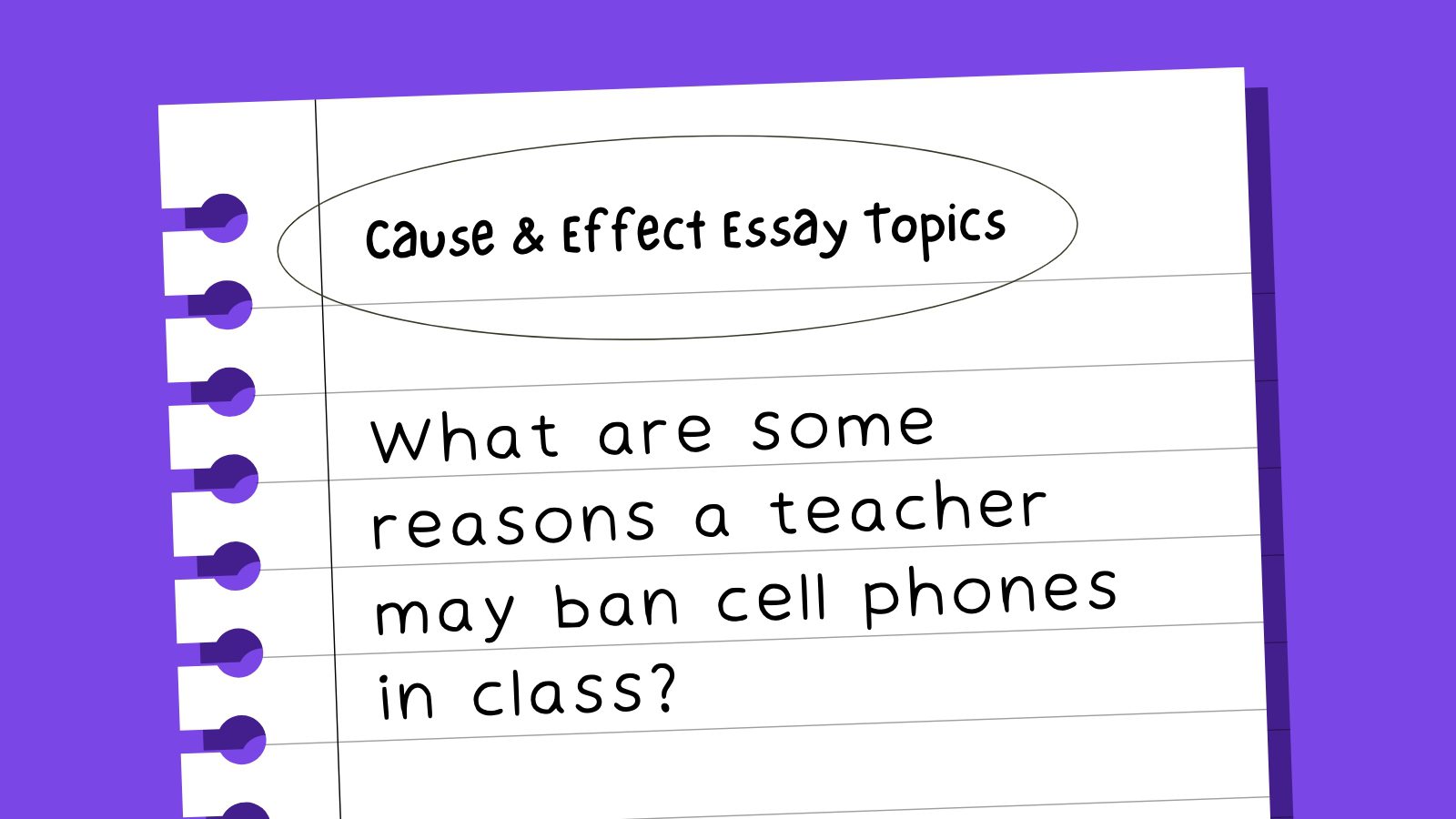
Cause-and-effect essays aren’t just a way to help students strengthen their writing skills. They’ll also learn critical thinking, logic, and the art of persuasion. In addition, they teach students to demonstrate how one thing directly influences another. Coming up with engaging cause-and-effect essay topics can be challenging, but we have you covered. This list of ideas includes a variety of topics that range from social and cultural movements to mental health and the environment.
Science and Environment Cause & Effect Essay Topics
- Describe the effect of urbanization on the environment.
- What is the impact of air pollution on health?
- What are the causes and consequences of plastics on marine life?
- What is the impact of rising sea temperatures on fish and marine life?
- Describe the impact of human behavior on global warming.
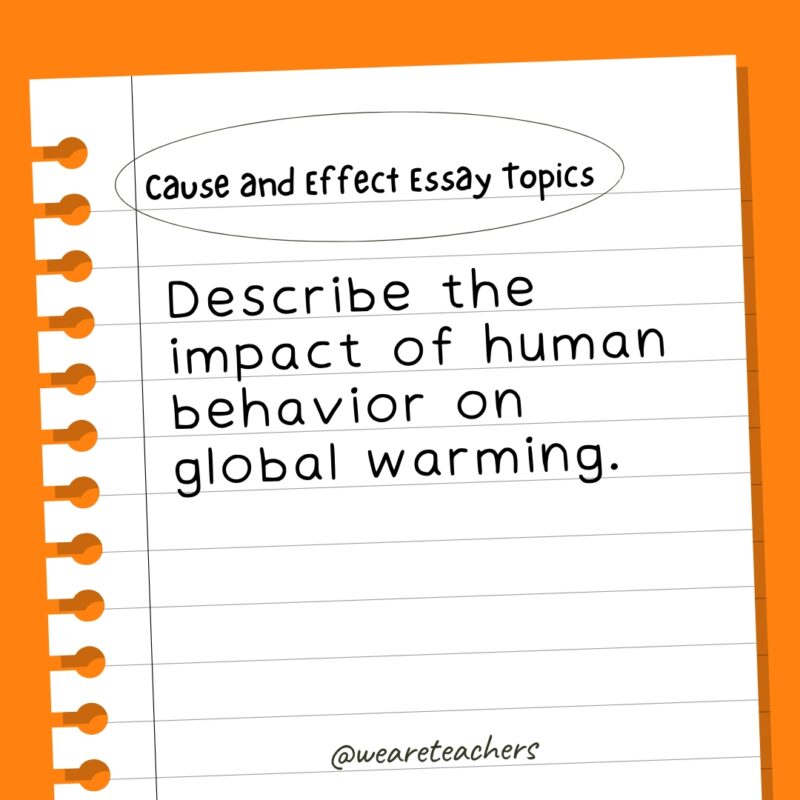
- What is the effect of social media on environmentalism?
- What causes volcanic eruptions?
- What causes trees to die?
- What are the effects of gravity?
- Why are plants green?
- Why do trees shed their leaves?
- What causes a species to become endangered?
- What are some of the causes of animals losing their habitats?
- Describe the effect of overpopulation on the environment.
- What are the effects of famine on human population?
- What are the causes and effects of Antarctica floods?
- What are the effects of pollution on the ocean?
- What effect do cars have on the environment?
- Why is it important to manage wildfires?
- What has been the impact of DNA on crime scene processing?
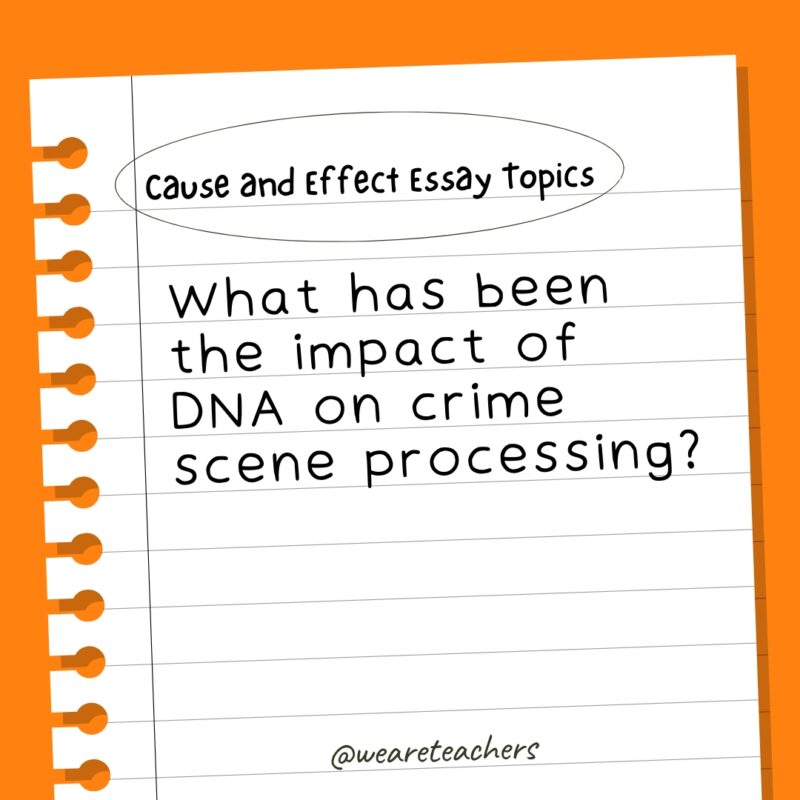
- What are the impacts of deforestation in Brazil?
- What are the effects of GMO foods on human health?
- What are the impacts of immunizations on human health?
Technology and Social Media Cause & Effect Essay Topics
- What are the effects of social media on adolescent development?
- How does technology affect productivity?
- What are the effects of video games on childhood development?
- How do cell phones affect human relationships?
- What are some reasons a teacher might ban cell phones from class?
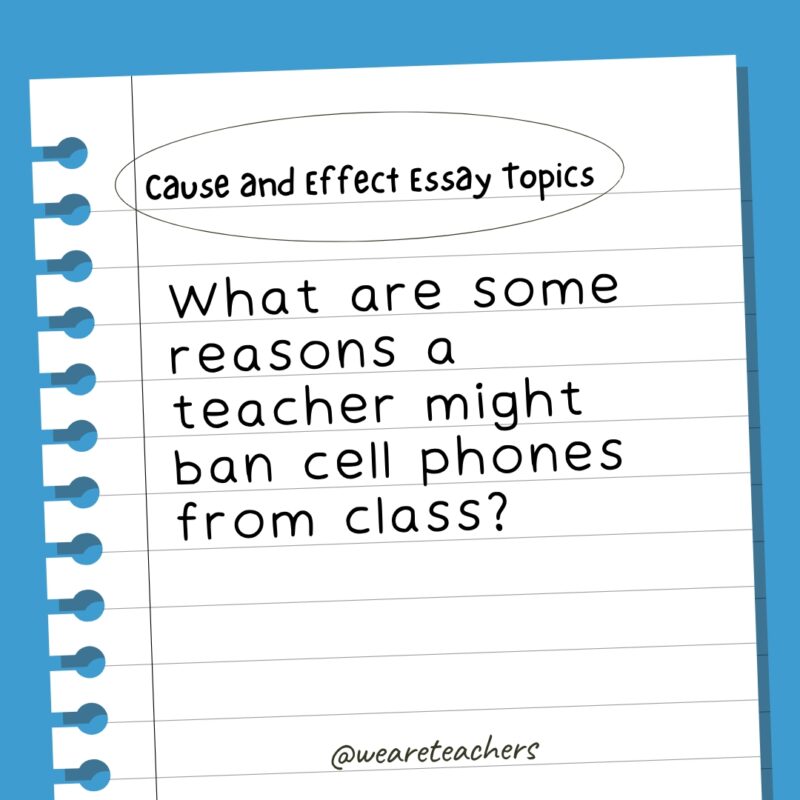
- What effects do cell phones have on sleep?
- What effects did the invention of the Internet have on technology?
- What were the origins of cyberbullying?
- What are the effects of tablet use on small children?
- How has online dating changed relationships?
- What makes some people less likely to use social media?
- What are the effects of social media on privacy?
- How does the rise of TikTok affect Facebook and Instagram?
- In what ways could social media lead to extremism?
- What is the impact of social media on the increasing popularity of plastic surgery and other enhancements?
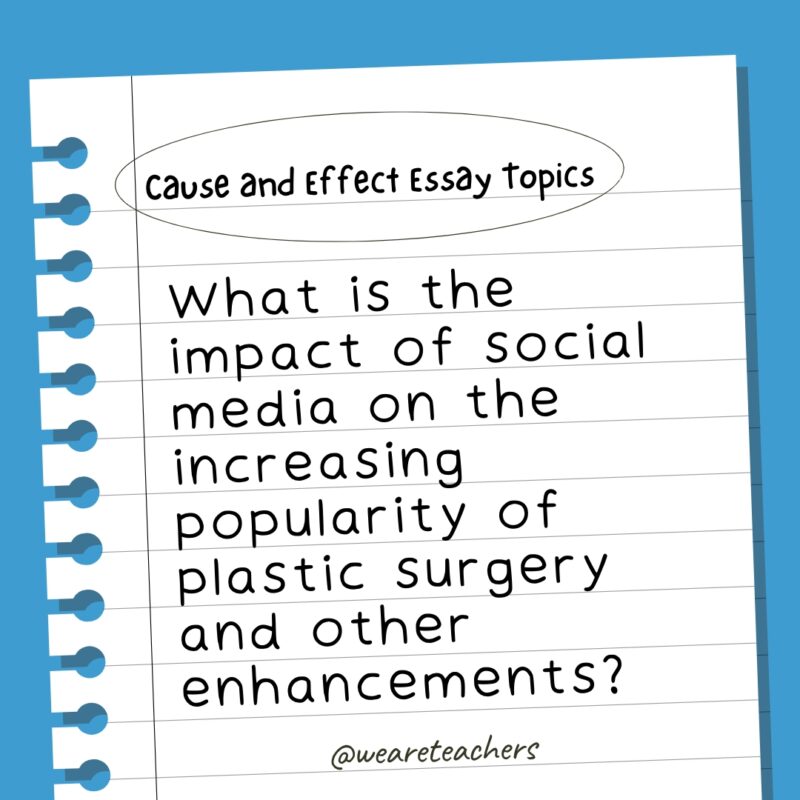
- What are some of the benefits of owning a smartphone and what are some of the drawbacks?
- What has been the impact of online shopping on brick-and-mortar stores?
- What has been the impact of smartphones on marriages and relationships?
- What are the causes and effects of texting while driving?
- What has the rise of “influencers” meant for Hollywood?
- In what ways have photo filters influenced young people’s self-esteem?
Culture and Social Issues Cause & Effect Essay Topics
- What are some of the reasons for substance abuse in young people?
- What are some of the effects of bullying?
- How does economic status affect the quality of health care?
- What are some of the causes of homelessness?
- Explain the effects of ignorance on discrimination.
- What are the impacts of death sentences on social justice?
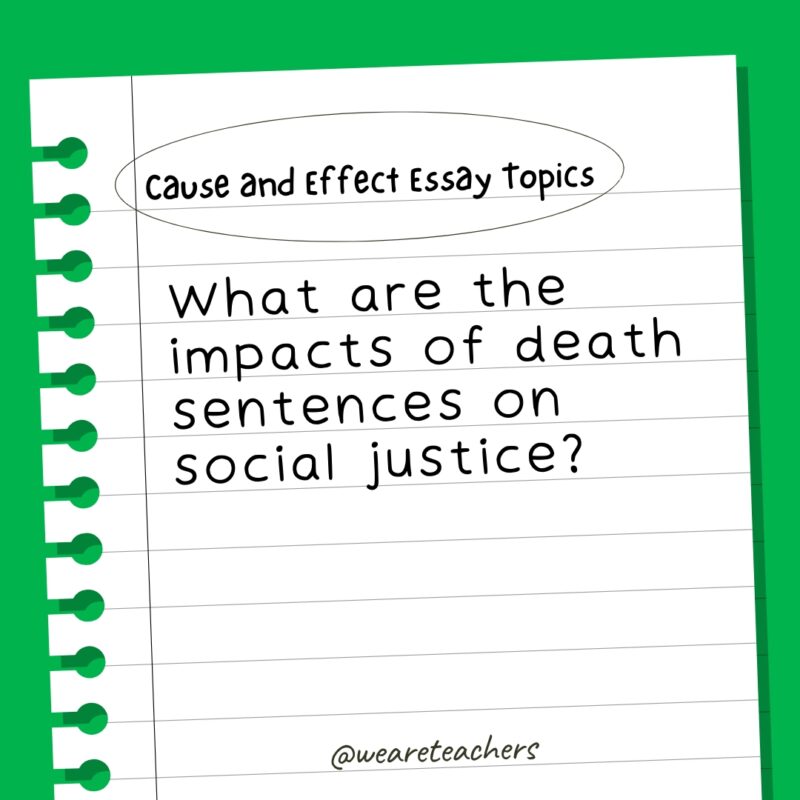
- How does financial success affect societal privilege?
- What effects does growing up poor have on children?
- In what ways does religion influence society?
- What are the effects of immigration on a host country?
- What are the effects of ageism on job opportunities?
- What is the impact of LGBTQ+ representation in TV and movies?
- What are the effects of school shootings on politics?
- How do school uniforms affect students?
- What are the impacts of high student debt?
- What are the impacts of body shaming on people?
- What were the lasting impacts of the AIDS epidemic on society?
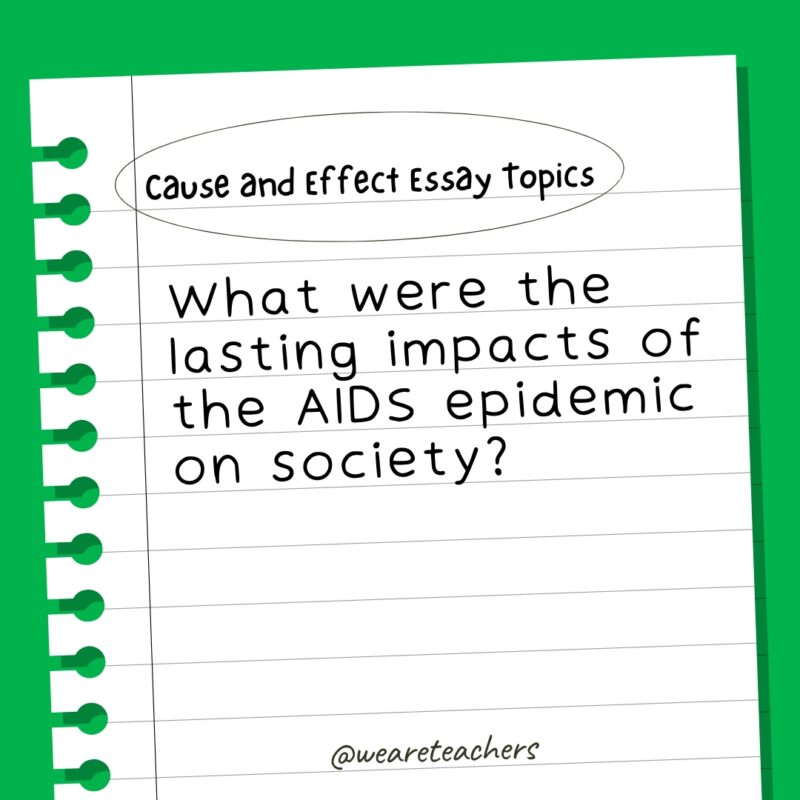
- What impact does banning abortion have in the United States?
- What has been the impact of marriage equality in the United States?
- What are the causes and effects of noise pollution?
- What are the causes and effects of inflation on the economy?
- What are the effects of TV shows on our behavior?
Sports Cause & Effect Essay Topics
- Examine the effects of exercise on mental health.
- What led to baseball being an iconic American sport?
- What drives people to participate in extreme sports?
- In what ways did globalization affect modern sports?
- What were the effects of doping on amateur and professional sports?
- Select a sport and write about the historical factors that led to the popularization of that sport.
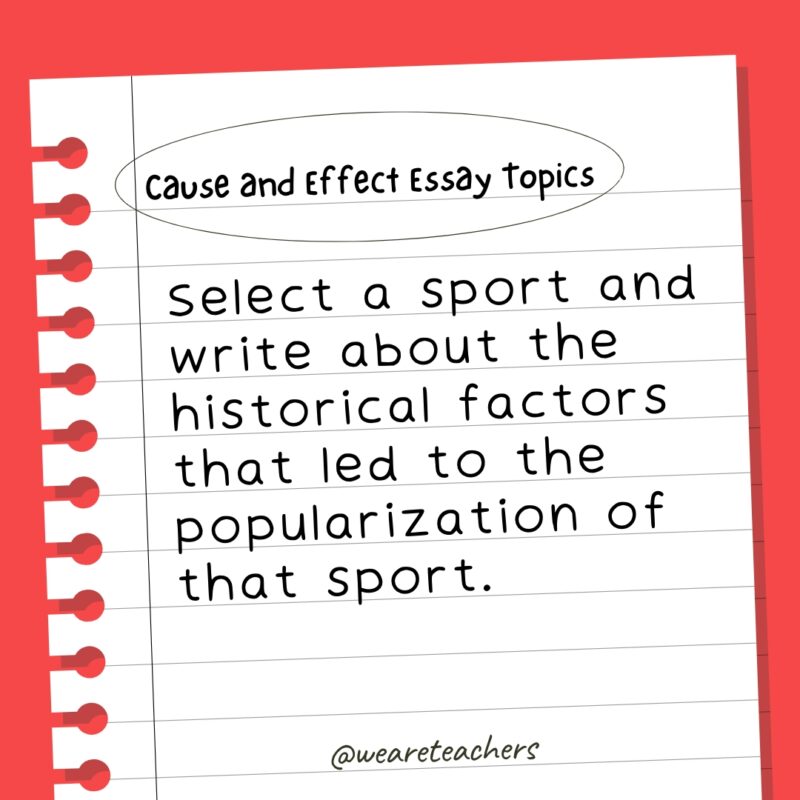
- Describe the ways in which youth sports influence a child’s development.
- What were the driving forces behind the first Olympics?
- How can team sports help develop social skills?
- How have e-sports changed the sporting landscape?
- In what ways do race biases influence sports?
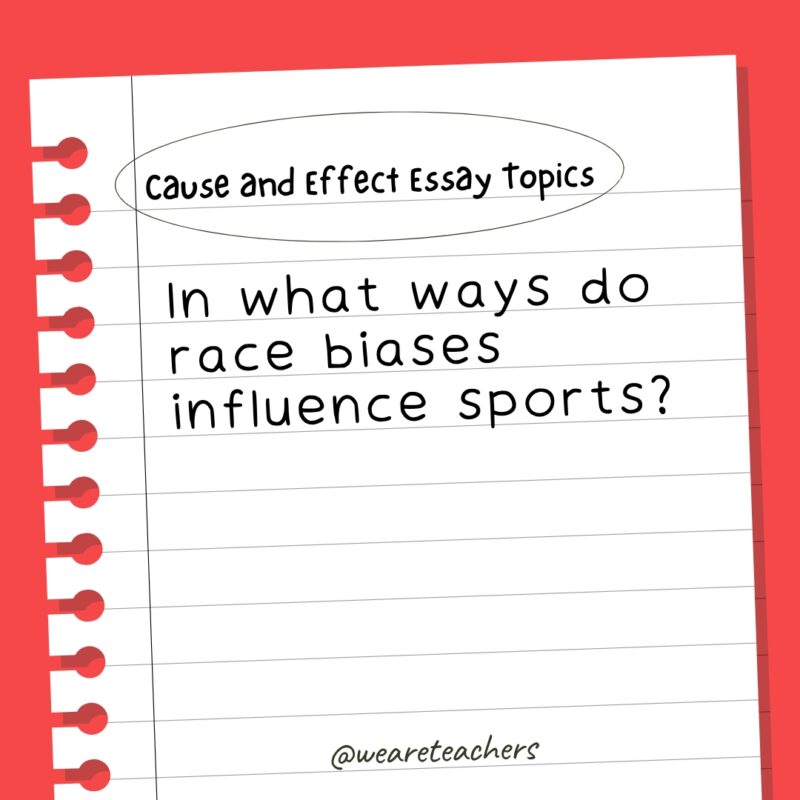
- What are the effects of regular workouts on immunity?
- How does participating in sports affect leadership skills?
- In what ways can sports lead to character development?
- What effect does famous athletes’ social commentary have on their fans?
History Cause & Effect Essay Topics
- What are the effects of the war in Syria on the United States?
- What have been the lasting effects of the Civil Rights Movement?
- What were the causes and effects of the attack on Pearl Harbor?
- What led up to the Berlin Wall being torn down and what effects did that have?
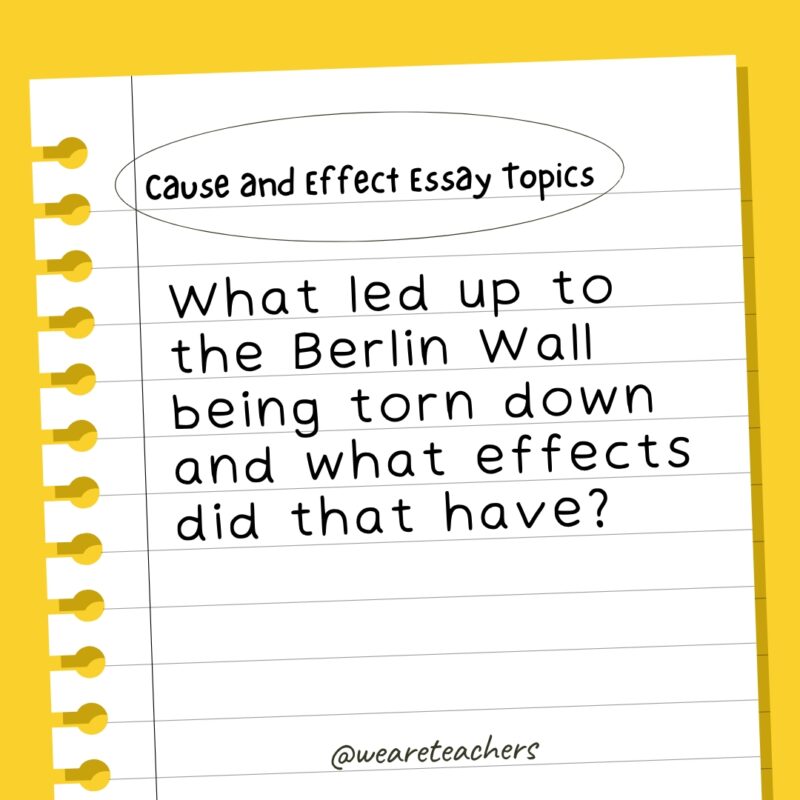
- What lasting impact did 9/11 have on modern American society?
- What were the causes of the Salem Witch Trials?
- What was the cultural impact of the Spanish-American War?
- How has globalization led to modern-day slavery?
- What events led to the fall of the Roman Empire?
- What were the impacts of the Great Depression on women’s employment?
- How did cartels come into existence? What effect have they had on the United States and Mexico?
- What were the causes and effects of the Women’s Liberation Movement?
- Give an example of colonialism in history and name the resulting impact to the affected society.
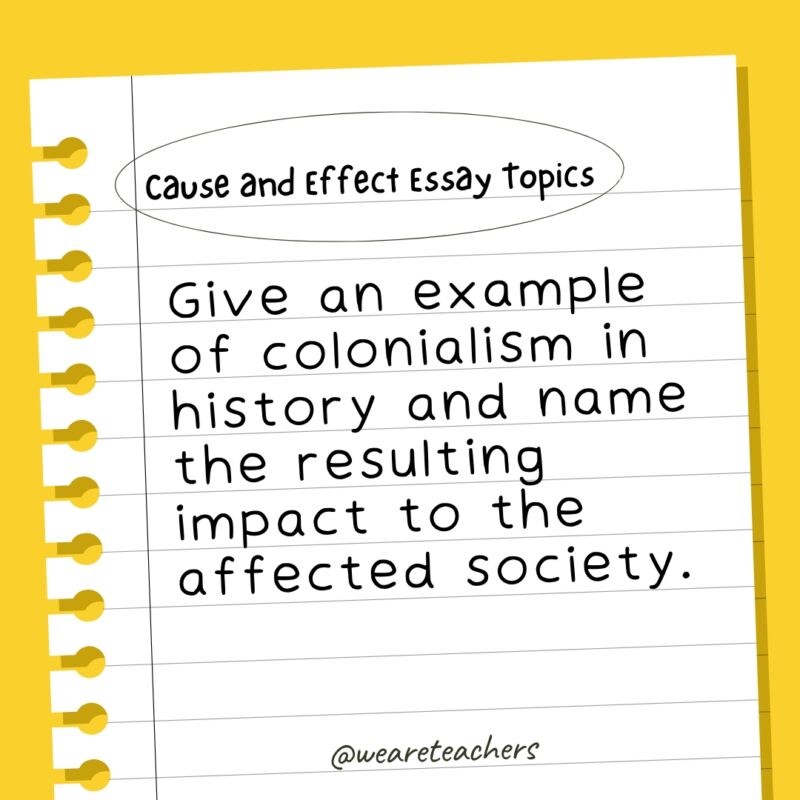
- What led to the rise of ISIS and what has the impact been on international security?
- What factors led to the Titanic’s sinking?
- What were the causes and effects of the Vietnam War?
- Choose an American president. What led him to become president and what were the effects of his presidency?
Mental Health Cause & Effect Essay Topics
- How can stress affect the immune system?
- How does social anxiety affect young people?
- How can high academic expectations lead to depression?
- What are the effects of divorce on young people?
- How does service in the armed forces lead to post-traumatic stress disorder?
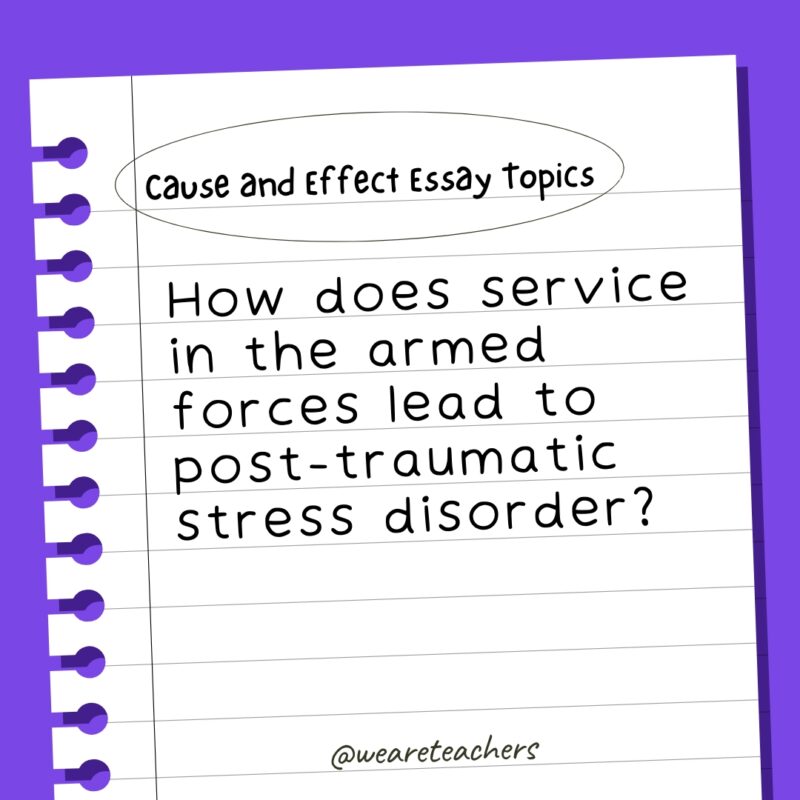
- What are the effects of mindfulness on mental health?
- Describe the ways in which the COVID-19 pandemic has impacted mental health.
- How does childhood trauma impact childhood development?
- What impact does witnessing violence have on mental health?
- What is behind increasingly high levels of anxiety in modern American society?
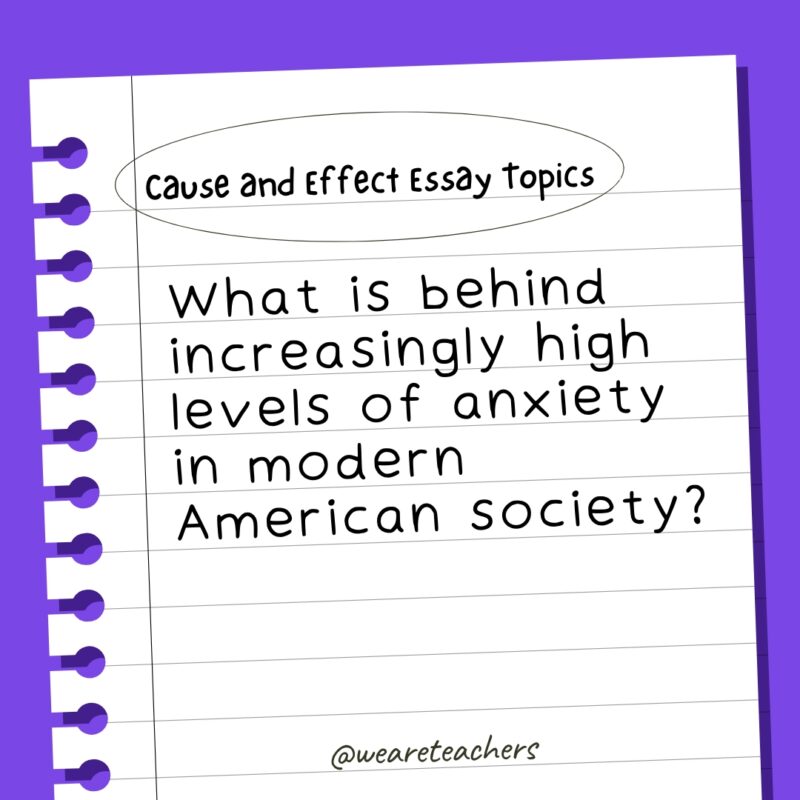
- What are the causes and effects of panic attacks?
- What are the causes and consequences of high stress in the workplace?
- What are some of the causes of insomnia and in what ways does it affect mental health?
- What is the impact of staying home for an extended period of time?
Current Events Cause & Effect Essay Topics
- Choose a local public education campaign. What are the effects of that campaign?
- What are the causes and effects of migration?
- What are the causes and effects of terrorist attacks?
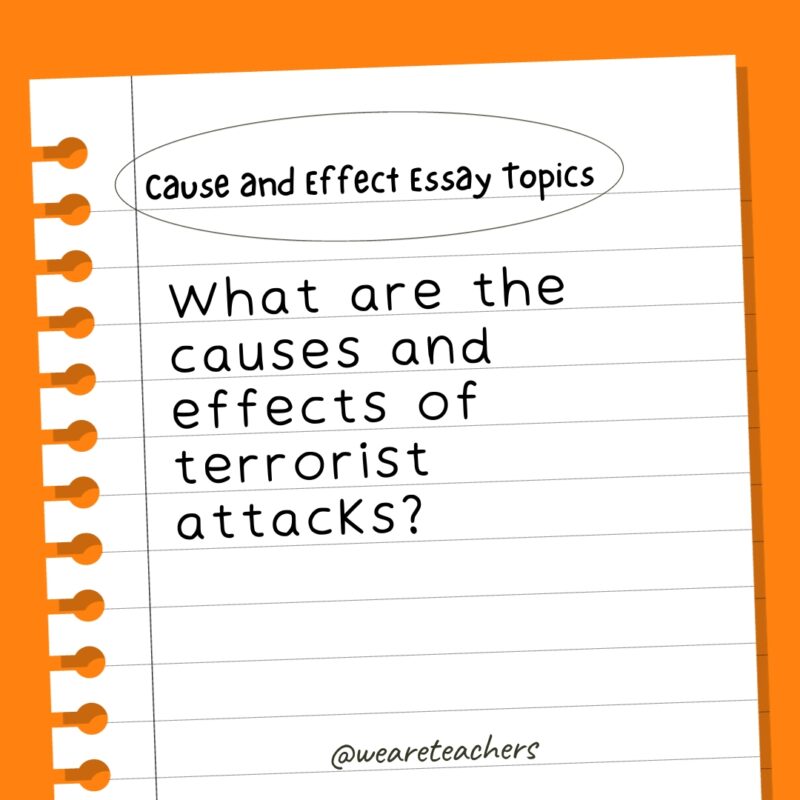
- What are the effects of legalizing genetic engineering research?
- How do low voting rates impact elections and government?
- What is the effect of raising the minimum wage?
- What are the effects of globalization on society?
- How does gerrymandering affect election outcomes?
- What are the causes and effects of police brutality?
- What are the causes and effects of political polarization?
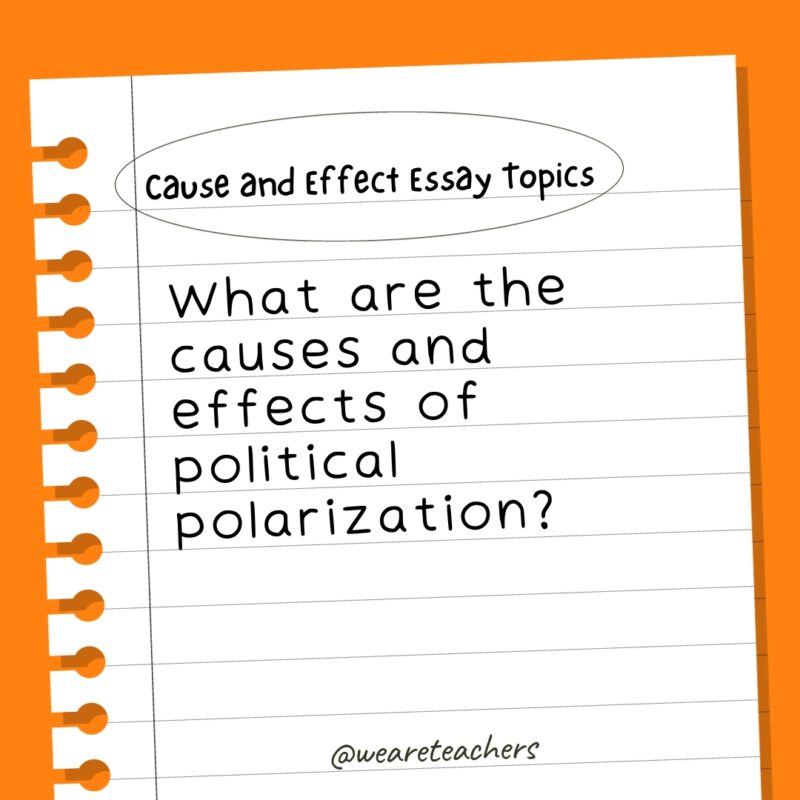
- What are the causes and effects of fake news?
- What are the effects of global war on citizens?
- What is the effect of international aid on poverty or health?
- Why do some countries have nuclear weapons, and what does this mean for other countries?
Education Cause & Effect Essay Topics
- What are the effects of teacher quality on student success?
- What are the causes and effects of student loan debt?
- What are the causes and effects of low graduation rates?
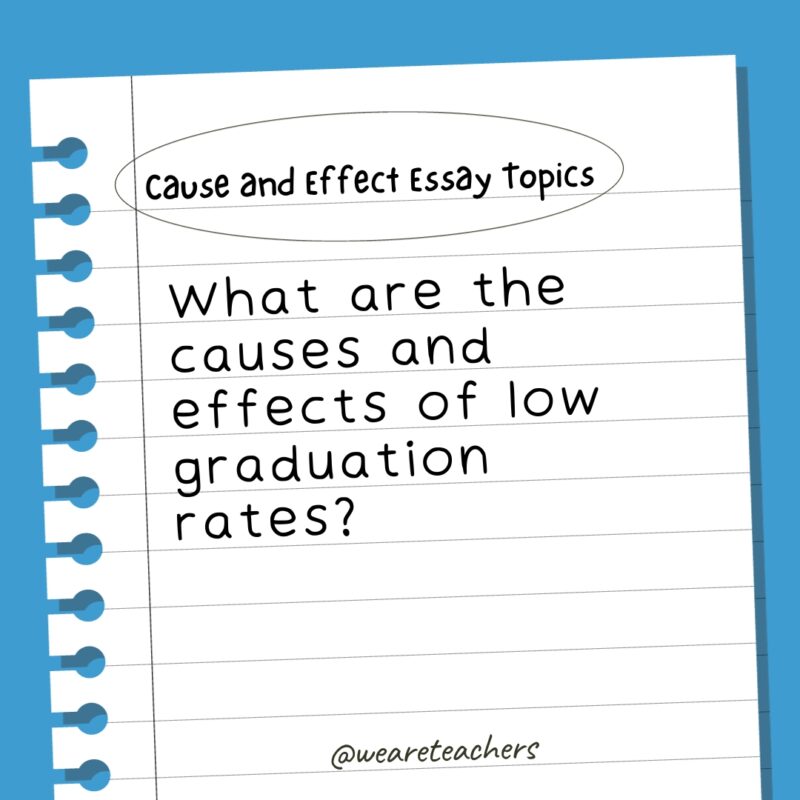
- What are the effects of assigning homework?
- What are the causes and effects of school funding disparities?
- What are the causes and effects of the digital divide in education?
- What is the effect of AI on education?
- What are the causes and effects of student burnout?
- Should students be required to study a foreign language in school, and what are the effects of learning a foreign language?

- What effect has the COVID pandemic had on education?
- What are the effects of same-sex classrooms or schools?
What are your best cause-and-effect essay topics for students? Come exchange ideas in the We Are Teachers HELPLINE group on Facebook.
Plus, check out our list of interesting persuasive essay topics for kids and teens..
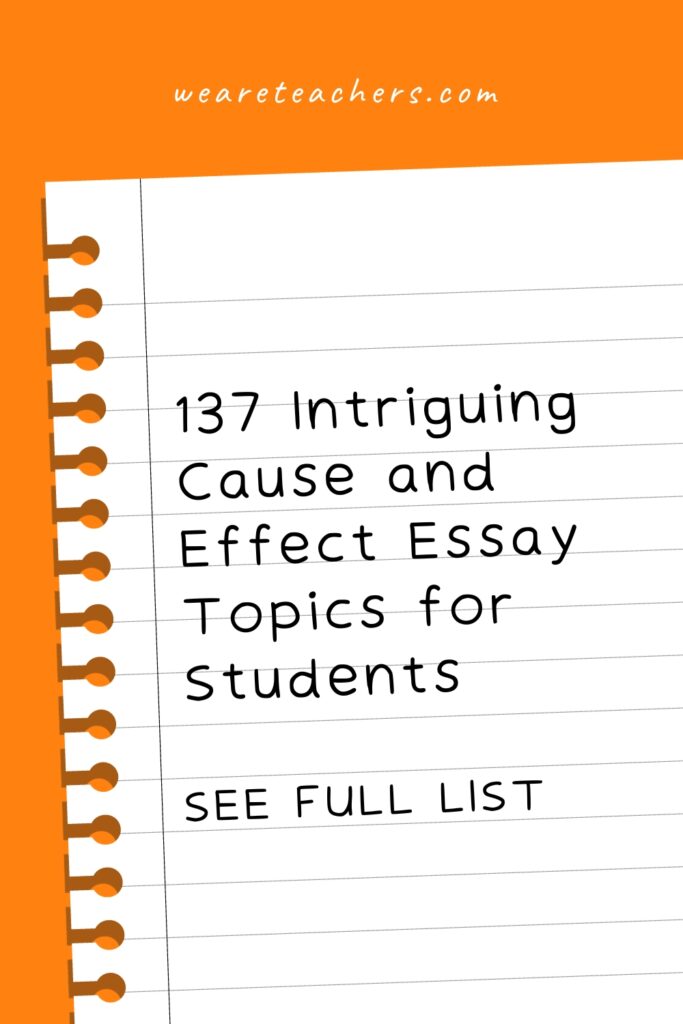
You Might Also Like

80 Intriguing Compare and Contrast Essay Topics for Kids and Teens
Android vs. iPhone? Capitalism vs. communism? Hot dog vs. taco? Continue Reading
Copyright © 2024. All rights reserved. 5335 Gate Parkway, Jacksonville, FL 32256
Purdue Online Writing Lab Purdue OWL® College of Liberal Arts
Welcome to the Purdue Online Writing Lab

Welcome to the Purdue OWL
This page is brought to you by the OWL at Purdue University. When printing this page, you must include the entire legal notice.
Copyright ©1995-2018 by The Writing Lab & The OWL at Purdue and Purdue University. All rights reserved. This material may not be published, reproduced, broadcast, rewritten, or redistributed without permission. Use of this site constitutes acceptance of our terms and conditions of fair use.
The Online Writing Lab (the Purdue OWL) at Purdue University houses writing resources and instructional material, and we provide these as a free service at Purdue. Students, members of the community, and users worldwide will find information to assist with many writing projects. Teachers and trainers may use this material for in-class and out-of-class instruction.
The On-Campus and Online versions of Purdue OWL assist clients in their development as writers—no matter what their skill level—with on-campus consultations, online participation, and community engagement. The Purdue OWL serves the Purdue West Lafayette and Indianapolis campuses and coordinates with local literacy initiatives. The Purdue OWL offers global support through online reference materials and services.
Social Media
Facebook twitter.
The History Teacher

19 pages • 38 minutes read
A modern alternative to SparkNotes and CliffsNotes, SuperSummary offers high-quality Study Guides with detailed chapter summaries and analysis of major themes, characters, and more.
Poem Analysis
Symbols & Motifs
Literary Devices
Further Reading & Resources
Discussion Questions
Form and Meter
As a Postmodern poem, “The History Teacher” is written in free verse , with no strict form, meter , or end rhyme . The poem has 22 lines broken up into six stanzas: a quatrain , a couplet , another quatrain, a tercet, and two final quintains. These inconsistent stanza breaks suggest the uneven pacing of the teacher’s course and his dismissal and underemphasis of historical violence.

Don't Miss Out!
Access Study Guide Now
Related Titles
By Billy Collins
Another Reason Why I Don’t Keep A Gun In The House
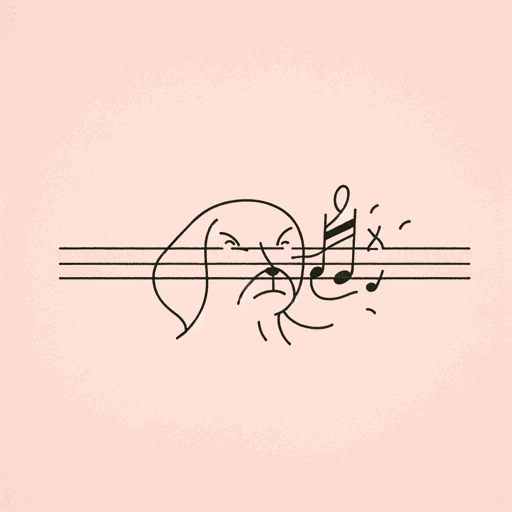
Forgetfulness
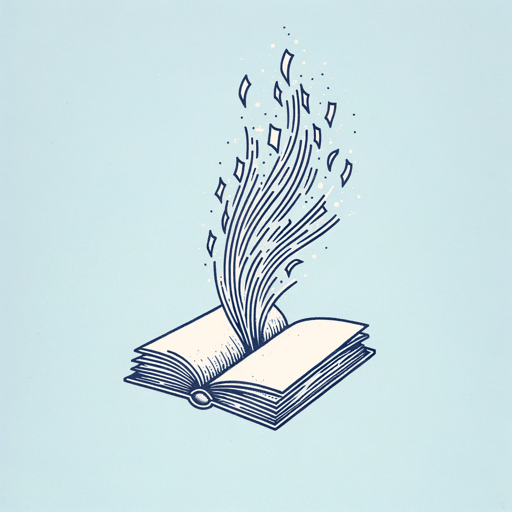
Introduction to Poetry
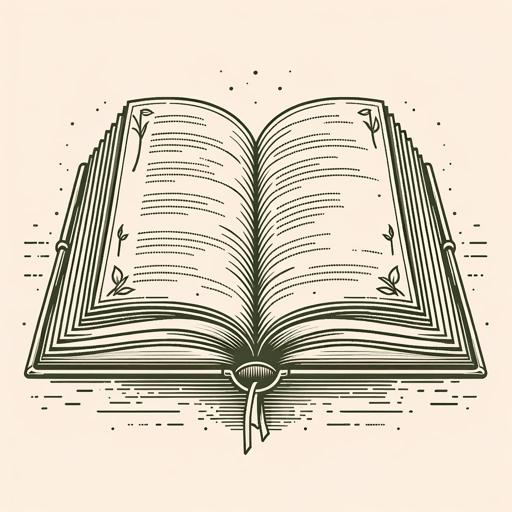
On Turning Ten

Featured Collections
Childhood & Youth
View Collection
Laugh-out-Loud Books
Poems of Conflict
Safety & Danger
School Book List Titles
Short Poems
Truth & Lies
Top of page

“Canned Childhood”: Encouraging Student Understanding of Progressive Era Issues and Reform Strategies Through a Poem Related to Child Labor
June 11, 2024
Posted by: Cheryl Lederle
Share this post:
Stacie Moats of the Library of Congress contributed to this post.
In the May/June 2024 issue of Social Education , the journal of the National Council for the Social Studies, our “Sources and Strategies” article features a poem published in the March 14, 1914, special child labor edition of the Maryland Suffrage News, “ Canned Childhood.” The article situates the poem and newspaper in the Progressive era and describes ideas for exploring the poem with students. It then offers teaching ideas to extend thinking and research about child labor reform into various social studies disciplines, drawing from the whole newspaper issue.
Progressive reformers addressed many causes, including rights for women and working conditions in factories, especially for children. They took the perspective that the causes were related and improving one would improve society overall. The article discusses Cleghorn’s work as a poet and a reformer. It suggests engaging students by first asking them to list the attributes of a good childhood and then introducing the poem. To better understand Cleghorn’s point, students might consider the poem’s title and the use of “canned.” Then ask: What is lost and what is gained, according to the first stanza? The poem concludes:
“Come buy, my fellow-countrymen! …Come buy sweet childhood by the can.”
Challenge students to read the last stanza and explain what they think Cleghorn meant about the role of society in the losses of “canned childhood.”

To extend learning, students might explore other parts of the newspaper, such as the article “Legislation for Children and Legislation for Vegetables” that follows the poem on the same page. The paper also includes additional poems, a political cartoon, and many additional articles, offering students a unique opportunity to compare the effectiveness of the various newspaper features in persuading readers to take action. The class might share their discoveries in a jigsaw activity.
Suggested discipline-specific approaches include:
- Geography – analyze items from the National Child Labor Committee collection the incorporate maps to make a point, such as this map or this exhibit panel . Or explore the collection for its geographic reach by selecting the “Collection Items” tab and then choosing the “More Locations” option from the left column.
- Economics – research to learn the monetary costs of the “Canned childhood [that’s] selling cheap” and how that fit into typical family budgets for different social classes of the time. They might develop questions to guide further research, such as “How much economic decision-making and influence did women have in this era, before they could vote?”
- History – read the section in Chronicling America “ About ” the Maryland Suffrage News to put child labor reform in the context of other events and movements of the time. Students might also analyze items selected from the Child Labor Primary Source Set for teachers.
- Civics – search recent legislation in Congress.gov or explore the Bound Congressional Record for past legislation.
Please share your students’ discoveries and questions in the chat!
Do you enjoy these posts? Subscribe ! You’ll receive free teaching ideas and primary sources from the Library of Congress.
Comments (2)
POWERFUL! Thank you for sharing this poem.
My pleasure, Michelle.
See All Comments
Add a Comment Cancel reply
This blog is governed by the general rules of respectful civil discourse. You are fully responsible for everything that you post. The content of all comments is released into the public domain unless clearly stated otherwise. The Library of Congress does not control the content posted. Nevertheless, the Library of Congress may monitor any user-generated content as it chooses and reserves the right to remove content for any reason whatever, without consent. Gratuitous links to sites are viewed as spam and may result in removed comments. We further reserve the right, in our sole discretion, to remove a user's privilege to post content on the Library site. Read our Comment and Posting Policy .
Required fields are indicated with an * asterisk.
The History Teacher Themes
By billy collins.
These notes were contributed by members of the GradeSaver community. We are thankful for their contributions and encourage you to make your own.
Written by Elizabeth Shaw
Cruel to be kind
This poem shows that sometimes it is necessary to listen to things that are not nice to hear. Collins illustrates this argument by using irony, telling the story of a history teacher who changes key events in history to make them sound nice to his students. However, in doing so the teacher is misinforming his students, which is never a good thing. Overall, in this humorous poem, Collins shows that sometimes sugar-coating can lead to misinformation.
Ultimately, for this poem to work on a humorous level, we must value the truth. As readers, we understand that the teacher's sugar-coated reading of history is something that students should not be taught, as it clouds the truth. Perhaps Collins is suggesting that children ought to be told the truth, even if it might upset them.
The importance of history
The poem suggests that knowing about history is important, as we can learn from what has happened in the past. In this poem, when the children don't learn about history there is an increase in bullying. Collins suggests that this is a direct result of their ignorance about history.
Update this section!
You can help us out by revising, improving and updating this section.
After you claim a section you’ll have 24 hours to send in a draft. An editor will review the submission and either publish your submission or provide feedback.

The History Teacher Questions and Answers
The Question and Answer section for The History Teacher is a great resource to ask questions, find answers, and discuss the novel.
Study Guide for The History Teacher
The History Teacher study guide contains a biography of Billy Collins, literature essays, quiz questions, major themes, characters, and a full summary and analysis.
- About The History Teacher
- The History Teacher Summary
- Character List

IMAGES
VIDEO
COMMENTS
'The History Teacher' was first published in Collins's 1991 collection, Questions About Angels.It was with this collection that his star began to rise. It is generally cited as his best-known volume. Like the majority of Collins's poems, he uses humor and a satirical outlook on the world in order to make a larger point about a specific topic. The teacher in this poem ignores the ...
Learn More. "The History Teacher" first appeared in Billy Collins's 1991 poetry collection Questions About Angels. The poem depicts a history teacher who strives to preserve his students' innocence by telling them sugarcoated, fictitious versions of historical events with all suffering or cruelty removed. Despite his efforts to hide the truth ...
The history teacher in the poem is portrayed as someone who manipulates the facts to fit his own agenda, teaching his students a sanitized version of history that ignores the darker aspects of the past. This is a critique of the way history was often taught in the 1990s, with a focus on American exceptionalism and a reluctance to confront the ...
Popularity of "The History Teacher": The poem, 'The History Teacher' is a remarkable poem, written by Billy Collins, one of the prestigious American poets. This poem first appeared in 1991 in his poetry collection, Questions about Angles.It presents an extraordinary role of a teacher who strives to exhibit a sugar-coated version of the cruel and rigid historic events.
Analysis: "The History Teacher". The speaker is omniscient and unidentified. Their subject is a nondescript history teacher. They have access to both the teacher's interior thoughts and to things of which the teacher is unaware. As a result, there is a distance created within the poem. This distance between speaker and subject allows the ...
Poem: "The History Teacher," by Billy Collins from Questions About Angels (University of Pittsburgh Press). The History Teacher. Trying to protect his students' innocence he told them the Ice Age was really just the Chilly Age, a period of a million years when everyone had to wear sweaters. And the Stone Age became the Gravel Age,
The poem's speaker describes a history teacher who is "[t]rying to protect his students' innocence" (Line 1). To do so, he revises historical information to present a sugarcoated version of the past. In the first and second stanzas, he makes the past milder, calling the Ice Age the "Chilly Age" (Line 3) and the Stone Age the ...
Study Guide for The History Teacher. The History Teacher study guide contains a biography of Billy Collins, literature essays, quiz questions, major themes, characters, and a full summary and analysis. The The History Teacher Community Note includes chapter-by-chapter summary and analysis, character list, theme list, historical context, author ...
The poem is about a history teacher, who, instead of doing his job and teaching his students about the true and brutal parts of history, sugar-coats the events in a comical way. For example, when the history teacher is asked about the Ice Age, he downplays it as simply being a " Chilly " age where "everyone had to wear sweaters.".
The History Teacher Poem Text. These notes were contributed by members of the GradeSaver community. We are thankful for their contributions and encourage you to make your own. Written by people who wish to remain anonymous. The History Teacher (Excerpt) Trying to protect his students' innocence. he told them the Ice Age was really just.
The teacher reinforces their ignorance in his attempt to protect their innocence. The teacher's childlike wordplay reveals how the teacher is trying to mimic a child's thought process. The students' violent and aggressive behavior on the playground suggests that ignorance prevents children from developing empathy and compassion.
The aim of the old history teacher is to protect his students' innocent, revealed from the first line, so that he creates harmless version of events in history. That killed me. I love kids, they are innocent and so kind and pretty. And the thing is they don't aware of them being like that.When I read this, I'm so damn near to find this ...
The History Teacher. Trying to protect his students' innocence. he told them the Ice Age was really just. the Chilly Age, a period of a million years. when everyone had to wear sweaters. And the Stone Age became the Gravel Age, named after the long driveways of the time. The Spanish Inquisition was nothing more.
The History Teacher Poem Analysis. 817 Words4 Pages. Through the common use of poetic devices, the two poems share a common theme: innocence. Whether it is the losing of one's innocence or protecting others innocence; the poets try to advised other with their words to not repeat the mistakes as their speakers did.
"The History Teacher" is an example of a poem that is constructed primarily of the literary technique of irony. Irony positively oozes from almost every line. One might argue that the greatest irony of the story is that despite protecting his students from the depths of human depravity by whitewashing history, they become bullies nevertheless.
The poem told a story of a history teacher conflicted by his personal moral when he is forced to wake up these children to the gore of real life. The History teacher, in an attempt to protect the innocence of his students, and protect them from the harsh realities of life. He tells the students a very fabled and watered down version of history.
The Teacher. The poem's subject, a nondescript history teacher, stands in for those who seek to present a simplified and moralistic history to children. The history lessons that are taught in the poem are symbolic of society's desire to protect children and sanitize history. The War of Roses becomes a disagreement that "took place in a ...
SuperSummary's Poem Study Guide for "The History Teacher" by Billy Collins provides text-specific content for close reading, engagement, and the development of thought-provoking assignments. Review and plan more easily with poet biography, literary device analysis, essay topics, and more. Note: This rich poem-study resource for teacher and student support does not contain activities ...
Poetry can be divided up into different forms, more easily expressing an author's emotions and intent with their poetry. For analyzing purposes I chose the poems Self-Help by Michael Ryan, Ghazal by Agha Shahid Ali, Psalm 150 by Jericho Brown, and Emergency by Michael Dylan Welch.
I too, dislike it: there are things that are important beyond all this fiddle. Reading it, however, with a perfect contempt for it, one discovers that there is in it after all, a place for the genuine. Hands that can grasp, eyes that can dilate, hair that can rise if it must, these things are important not because a
Pair this Black history poem with readings from the play to give students a more complete picture of daily life for many Black Americans during the 1950s. ... a community of Black writers. The author of many books of poetry and nonfiction essays, he was awarded a Stegner Fellowship from Stanford University, the Quill Award in Poetry, and the ...
The History Teacher was written by former US Poet Laureate Billy Collins as part of his anthology collection Questions About Angels (1991). In the poem, a teacher fails to do his job properly as a history teacher, and instead decides to create his own fictitious history to teach his students. He takes major events in history and changes them to ...
Cause-and-effect essays aren't just a way to help students strengthen their writing skills. They'll also learn critical thinking, logic, and the art of persuasion. In addition, they teach students to demonstrate how one thing directly influences another.
Teachers and trainers may use this material for in-class and out-of-class instruction. Mission The On-Campus and Online versions of Purdue OWL assist clients in their development as writers—no matter what their skill level—with on-campus consultations, online participation, and community engagement.
The History Teacher study guide contains a biography of Billy Collins, literature essays, quiz questions, major themes, characters, and a full summary and analysis. The The History Teacher Community Note includes chapter-by-chapter summary and analysis, character list, theme list, historical context, author biography and quizzes written by ...
Form and Meter. As a Postmodern poem, "The History Teacher" is written in free verse, with no strict form, meter, or end rhyme. The poem has 22 lines broken up into six stanzas: a quatrain, a couplet, another quatrain, a tercet, and two final quintains. These inconsistent stanza breaks suggest the uneven pacing of the teacher's course and ...
Stacie Moats of the Library of Congress contributed to this post.. In the May/June 2024 issue of Social Education, the journal of the National Council for the Social Studies, our "Sources and Strategies" article features a poem published in the March 14, 1914, special child labor edition of the Maryland Suffrage News, "Canned Childhood." The article situates the poem and newspaper in ...
The Truth. Ultimately, for this poem to work on a humorous level, we must value the truth. As readers, we understand that the teacher's sugar-coated reading of history is something that students should not be taught, as it clouds the truth. Perhaps Collins is suggesting that children ought to be told the truth, even if it might upset them.